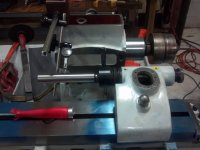I started this thread in part because the
geometry of the machine is not correct. The tailstock is higher than the work spindle, and the work spindle is closer to the front of the table than the tailstock. In the course of investigation, the need for new oil pockets in the ways came up, and that became a priority.
Now that the oil pockets and oil system are sorted out, I am back to fixing the geometry. First I followed Richard's suggestion of seeing what shims would be needed to make everything right. It needed:
- tailstock 0.002" = 50 microns shim towards the front of the table
- workhead lifted 0.004" = 100 microns on the right side and 0.005" = 125 microns on the left side.
My plan was to first scrape the workhead to bring it forward 0.002" and to tilt it down on the right by 0.001", and then to scrape in the tailstock to match. But as I was preparing for this, I then found the real cause of the misalignment.
I had removed the workhead, disassembled, cleaned and deburred the mount, and then checked it on a surface plate.
I had expected the test bar to point upwards as it had on the machine, but instead it pointed slightly *downwards*, about 30 microns = 0.0012" in 300mm = 12".
This pointed a finger at the table as the reason for the misalignment.
Then I measured the table, indicating it as it slid by on the machine. BINGO! It was level in the middle (orange section labeled level) but dropped down about 30 microns = 0.0012" on the left back and 70 microns = 0.003" on the left front. This makes the table tilt up and to the right, making the workhead also tilt up and to the right, resulting in the test bar being too high at the tailstock. Here is a picture showing those measurements (but after removing the swivel table)
Now what was responsible for the swivel table drooping down? I feared that it was bedway wear, but fortunately that was not the case. I first pulled off the swivel table and then indicated the fixed table below. Here is the fixed table:
On the left, as shown in the photo above, it is 5 microns = 0.0002" low in the front, and 12 microns = 0.0005" high in the back. But that is not enough to explain what I was seeing earlier.
Finally I investigated the swivel table. (My surface plate is not big enough to hold the entire swivel table, so this took a while.) It turns out that the TOP of the swivel table is flat to within a few microns, but the BOTTOM is not. When the bottom of the swivel table was ground, it appears that the area under the workhead got ground 130 microns = 0.005" too thin! So when the swivel table is clamped down, this pulls the left side of the swivel table down, making the workhead spindle point up and to the right.
I'm going to see if I can find a local shop that can clamp the swivel table upside down (as shown in the photo above) and regrind the bottom. They'll need to take about 0.005" = 130mm off to clean it up.
I wonder how it got like this. I suspect that someone rebuilt or reconditioned the machine and screwed this up. I can't imagine that it left the factory like that.
Cheers,
Bruce
PS: since only one pad on the swivel table is really messed up, an alternative might be to use a steel-filled adjustment material like DWH 310 fluid to "add back" the missing material. If I can find a 1-meter surface plate I could use that as a master for molding.






